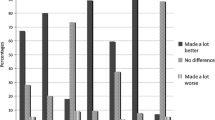Abstract
Background
Cyclic vomiting syndrome (CVS) is a chronic functional GI disorder; a characteristic compulsive “hot-water bathing” pattern is reported to alleviate symptoms during an acute episode. There is limited data on this bathing pattern: proposed mechanisms include core temperature increase via effects on cannabinoid type 1 receptors in the brain, skin transient receptor potential vanilloid 1 receptor stimulation, and blood flow shift from viscera to skin.
Aims
We thus sought to characterize the hot-water bathing pattern in patients with CVS and identify differences between heavy cannabis users in comparison to occasional and non-users.
Methods
We conducted a cross-sectional study of 111 patients with CVS at a single tertiary referral center. Questionnaires regarding clinical characteristics, hot-water bathing, and cannabis use were administered. Patients were classified based on cannabis usage into regular cannabis users (≥ 4 times/week), and occasional + non-users (< 4 times/week and no current use).
Results
A total of 81 (73%) respondents reported the hot-water bathing behavior during an episode. The majority (> 80%) noted a marked improvement in nausea, vomiting, abdominal pain and symptoms associated with panic. Regular cannabis users were more likely to use “very-hot” water (50% vs. 16%, p = 0.01) and time to relief of symptoms was longer (> 10 min) in this group, compared to the rest of the cohort.
Conclusions
Hot-water bathing relieves both GI and symptoms related to panic in most patients which appear to be modulated by chronic cannabis use. These findings can help inform future physiologic studies in CVS pathogenesis.


Similar content being viewed by others
References
Stanghellini V, Chan FK, Hasler WL, et al. Gastroduodenal disorders. Gastroenterology. 2016;150:1380–1392.
Fleisher DR, Gornowicz B, Adams K, Burch R, Feldman EJ. Cyclic vomiting syndrome in 41 adults: the illness, the patients, and problems of management. BMC Med. 2005;3:20.
Venkatesan T, Levinthal DJ, Li BUK, et al. Role of chronic cannabis use: cyclic vomiting syndrome vs cannabinoid hyperemesis syndrome. Neurogastroenterol Motil. 2019;31:e13606.
Aziz I, Palsson OS, Whitehead WE, Sperber AD, Simren M, Tornblom H. Epidemiology, clinical characteristics, and associations for Rome IV functional nausea and vomiting disorders in adults. Clin Gastroenterol Hepatol. 2018;17:876–886.
Venkatesan T, Zadvornova Y, Raff H, Hillard CJ. Endocannabinoid-related lipids are increased during an episode of cyclic vomiting syndrome. Neurogastroenterol Motil. 2016;28:1409–1418.
Levinthal DJ. The cyclic vomiting syndrome threshold: a framework for understanding pathogenesis and predicting successful treatments. Clin Transl Gastroenterol. 2016;7:e198.
Hejazi RA, Reddymasu SC, Namin F, Lavenbarg T, Foran P, McCallum RW. Efficacy of tricyclic antidepressant therapy in adults with cyclic vomiting syndrome: a two-year follow-up study. J Clin Gastroenterol. 2010;44:18–21.
Kumar N, Bashar Q, Reddy N, et al. Cyclic vomiting syndrome (CVS): is there a difference based on onset of symptoms–pediatric versus adult? BMC Gastroenterol. 2012;12:52.
Venkatesan T, Levinthal DJ, Tarbell SE, et al. Guidelines on management of cyclic vomiting syndrome in adults by the American neurogastroenterology and motility society and the cyclic vomiting syndrome association. Neurogastroenterol Motil. 2019;31:e13604.
Hikita T, Kodama H, Kaneko S, et al. Sumatriptan as a treatment for cyclic vomiting syndrome: a clinical trial. Cephalalgia. 2011;31:504–507.
Venkatesan T, Sengupta J, Lodhi A, et al. An Internet survey of marijuana and hot shower use in adults with cyclic vomiting syndrome (CVS). Exp Brain Res. 2014;232:2563–2570.
Allen JH, de Moore GM, Heddle R, Twartz JC. Cannabinoid hyperemesis: cyclical hyperemesis in association with chronic cannabis abuse. Gut. 2004;53:1566–1570.
Simonetto DA, Oxentenko AS, Herman ML, Szostek JH. Cannabinoid hyperemesis: a case series of 98 patients. Mayo Clin Proc. 2012;87:114–119.
Choung RS, Locke GR 3rd, Lee RM, Schleck CD, Zinsmeister AR, Talley NJ. Cyclic vomiting syndrome and functional vomiting in adults: association with cannabinoid use in males. Neurogastroenterol Motil. 2012;24:20–26.
Mechoulam R, Parker LA. The endocannabinoid system and the brain. Annu Rev Psychol. 2013;64:21–47.
Parker LA, Rock EM, Limebeer CL. Regulation of nausea and vomiting by cannabinoids. Br J Pharmacol. 2011;163:1411–1422.
Dlugos A, Childs E, Stuhr KL, Hillard CJ, de Wit H. Acute stress increases circulating anandamide and other N-acylethanolamines in healthy humans. Neuropsychopharmacology. 2012;37:2416–2427.
Hill MN, Miller GE, Carrier EJ, Gorzalka BB, Hillard CJ. Circulating endocannabinoids and N-acyl ethanolamines are differentially regulated in major depression and following exposure to social stress. Psychoneuroendocrinology. 2009;34:1257–1262.
Villares J. Chronic use of marijuana decreases cannabinoid receptor binding and mRNA expression in the human brain. Neuroscience. 2007;145:323–334.
Romanovsky AA, Almeida MC, Garami A, et al. The transient receptor potential vanilloid-1 channel in thermoregulation: a thermosensor it is not. Pharmacol Rev. 2009;61:228–261.
Acknowledgments
We are grateful to Mark Oium for support with REDCap.
Funding
None.
Author information
Authors and Affiliations
Corresponding author
Ethics declarations
Conflict of interest
Thangam Venkatesan is an ad hoc consultant for Takeda and Alnylam Pharmaceuticals. This does not have any bearing on the contents of this article. Cecilia Hillard serves on the scientific advisory boards for Beryl Therapeutics and Phytecs, Inc. and this does not pose any conflict of interest. The other authors have no relevant disclosures.
Additional information
Publisher's Note
Springer Nature remains neutral with regard to jurisdictional claims in published maps and institutional affiliations.
Rights and permissions
About this article
Cite this article
Rosen, S., Diaz, R., Garacci, Z. et al. Hot-Water Bathing Improves Symptoms in Patients with Cyclic Vomiting Syndrome and Is Modulated by Chronic Cannabis Use. Dig Dis Sci 66, 1153–1161 (2021). https://doi.org/10.1007/s10620-020-06343-x
Received:
Accepted:
Published:
Issue Date:
DOI: https://doi.org/10.1007/s10620-020-06343-x




